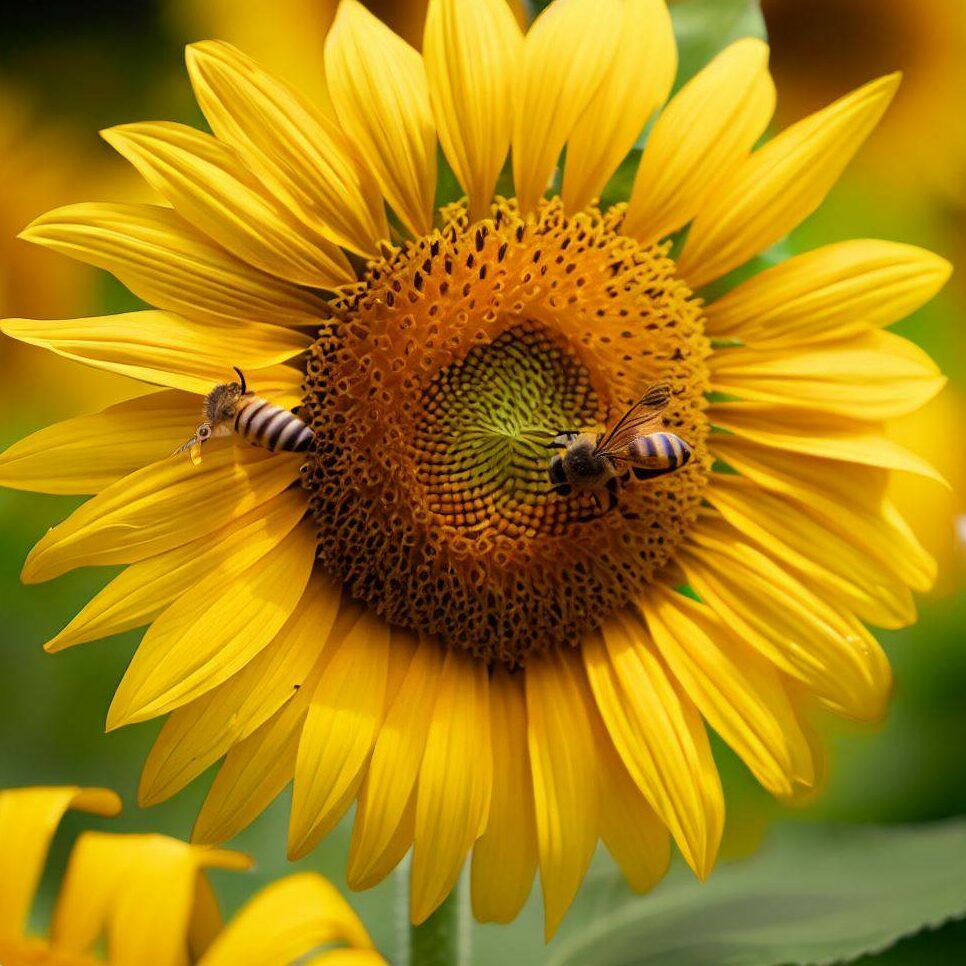The Phenomenon of Sunflowers Following the Sun
Sunflowers are renowned for their unique ability to follow the sun, a captivating behavior known as heliotropism in sunflower. This natural wonder has fascinated scientists and nature enthusiasts alike, leading to various studies and observations.
Do sunflowers follow the sun? Yes, they follow the sun’s path across the sky in a behavior known as heliotropism. This remarkable phenomenon is most prominent in young sunflowers, which actively face the sun as it moves from east to west. However, as sunflowers mature, they gradually settle facing east to optimize sunlight exposure for pollinators like bees. This natural dance with sunlight showcases the intricate relationship between sunflowers and their environment.
🌞 Sunflower Secret: Heliotropism is not exclusive to sunflowers. Many plants exhibit this behavior to maximize sunlight exposure, enhancing their growth and development. 🌞

Heliotropism Explained: Heliotropism in Sunflowers
Defining Heliotropism
Heliotropism, or solar tracking, is a phenomenon where plants move in response to the direction of the sun. In the context of sunflowers, heliotropism plays a vital role in their growth and development. Young sunflowers follow the sun from east to west during the day, maximizing their exposure to sunlight.
🌞 Sunflower Secret: Heliotropism is not just about following the sun. It’s a survival strategy that helps plants like sunflowers optimize photosynthesis, the process by which they convert sunlight into energy. 🌞
How Sunflowers Follow the Sun
Sunflowers follow the sun through a combination of growth and movement. Here’s how it happens:
- Morning: Sunflowers start facing east and gradually turn west as the sun moves across the sky.
- Evening: As the sun sets, sunflowers slowly return to their east-facing position, ready to start the cycle again the next day.
- Maturity: Once mature, sunflowers mainly face east, optimizing warmth for pollinators.
Sunflowers Follow the Sun Time-Lapse
Witnessing sunflowers follow the sun through a time-lapse is a mesmerizing experience. It provides a visual insight into this natural marvel. Below is a time-lapse video that captures the daily journey of sunflowers as they track the sun:
Sunflowers and the Sun: A Daily Journey
How Long Do Sunflowers Follow the Sun?
Young sunflowers follow the sun from sunrise to sunset, a daily journey that lasts around 12 to 14 hours during the summer months. This tracking behavior continues until the sunflower reaches maturity, at which point it mainly faces east. Interestingly, there are both annual and perennial sunflower varieties. Annual sunflowers complete their life cycle in one growing season, producing seeds and then dying off, while perennial sunflowers return year after year, showcasing their vibrant faces each summer.
🌞 Sunflower Secret: If you want to observe this phenomenon yourself, plant sunflower seeds in the spring and watch them grow. You’ll be able to see the sunflowers follow the sun throughout the day! 🌞
Why Do Sunflowers Follow the Sun?
Sunflowers follow the sun to maximize their exposure to sunlight, which aids in photosynthesis. This behavior helps them grow faster and stronger. The east-facing orientation in mature sunflowers also provides warmth for pollinators like bees.
Changing Direction: A Sunflower’s Daily Dance
Sunflowers change direction during the day through a combination of growth and movement. Here’s how:
- Morning: They start facing east and gradually turn west.
- Afternoon: They continue to follow the sun until it sets.
- Night: They return to their east-facing position, ready for the next day.
Do Sunflowers Face the Sun at Sunset?
Yes, young sunflowers do face the sun at sunset. They follow the sun’s path throughout the day, ending their journey facing west as the sun sets. Once mature, they mainly face east, but the tracking behavior can still be observed in the early stages of growth.
Facing East: The Mature Sunflower’s Behavior – Why Do Sunflowers Face East?
Understanding the Eastward Orientation
Mature sunflowers mainly face east, and this behavior is not just a random occurrence. It’s a result of the sunflower’s internal circadian rhythm, which reacts more strongly to morning light. As sunflowers mature, they gradually stop moving westward during the day, settling in an east-facing orientation.
🌞 Sunflower Secret: Want to observe this eastward orientation? Plant sunflowers in a location where they can receive ample morning sunlight, and watch as they mature and begin to face east. 🌞
The Relationship with Bees

The eastward orientation of mature sunflowers is not just about sunlight; it’s also about bees. Facing east allows the sunflowers to capture the warmth of the morning sun, creating a cozy environment for bees. This warmth attracts pollinators, enhancing the sunflower’s chances of successful pollination.
The Warmest Direction: A Strategic Choice
Why is east considered the warmest direction for sunflowers? Here’s a breakdown:
- Early Morning Sun: East-facing sunflowers capture the first rays of the day, warming up quickly.
- Attracting Pollinators: The warmth attracts bees, which are essential for pollination.
- Energy Efficiency: By facing east, sunflowers can maximize their energy use for growth and reproduction.
This strategic choice of facing east is a fascinating aspect of sunflower behavior, reflecting a complex interplay between growth, reproduction, and survival.
The Science Behind the Behavior – Unveiling the Sunflower’s Secrets
Exploring the Circadian Clock

The intriguing behavior of sunflowers following the sun is intricately tied to their circadian clock, an internal timekeeping system that regulates various physiological processes. This biological clock plays a vital role in guiding the sunflower’s movements throughout the day, ensuring they maximize their exposure to sunlight.
The Stimulus of the Sunflower
So, what prompts sunflowers to engage in heliotropism? The answer lies in photoreceptors, specialized cells that respond to light. These photoreceptors, particularly those in the stem, react to the direction and intensity of sunlight. As the sunflower detects sunlight, it triggers a hormonal response that influences its growth and movement.
🌞 Sunflower Secret: Want to observe the sunflower’s response to light? Try gently shading one side of the sunflower and observe how it gradually adjusts its orientation to face the light source. 🌞
Ongoing Scientific Research
The sunflower’s behavior remains a subject of ongoing scientific investigation. Researchers are delving deeper into the intricate mechanisms behind heliotropism, studying the molecular pathways and genetic factors that contribute to this captivating phenomenon. Insights gained from this research not only enhance our understanding of plant behavior but also provide valuable knowledge for agricultural and ecological applications.
As the sunflower turns its face toward the sun, it also turns the pages of scientific discovery, unveiling the secrets of its unique relationship with light.
Other Fascinating Aspects – Unveiling Sunflowers’ Mysteries
Sunflowers’ Nocturnal Behavior

Have you ever wondered if sunflowers droop at night? The answer lies in their response to light. As the sun sets, sunflowers undergo a remarkable transformation. At night, these vibrant blooms exhibit a phenomenon known as “nyctinasty,” where they close up their petals. This movement is not just a protective measure against the cold; it also helps the sunflower conserve energy and preserve its vitality for the coming day’s sunlight.
Sunflowers and the Moon
The enchanting relationship between sunflowers and the moon sparks curiosity. While sunflowers don’t exactly “follow” the moon in the same way they do the sun, there is evidence suggesting that their orientation can be influenced by the moon’s brightness. Sunflowers have been observed to orient themselves toward the moon, particularly in its absence during a cloudy night.
Unveiling the Heliotropic Mystery
The concept of heliotropism raises intriguing questions: Are sunflowers truly heliotropic? Heliotropism refers to the ability of plants to move or grow in response to sunlight. While sunflowers exhibit heliotropic behavior in their early stages, it diminishes as they mature. The complex interplay of hormonal responses and genetic factors contributes to this phenomenon, making sunflowers a fascinating subject of botanical exploration.
Exploring these aspects adds depth to our understanding of sunflowers and their intricate interactions with light, darkness, and the celestial bodies that grace our skies.
Conclusion – Embracing the Sunflower’s Dance
In the journey through the captivating world of sunflowers, we’ve uncovered the mysteries that lie within their daily dance with the sun. From their heliotropic nature in youth to their wisdom in orienting towards the moon, sunflowers remind us of the intricate relationships they share with light and darkness. As the petals close under the night sky, and the morning sun gently coaxes them open once again, we witness the harmonious rhythm of nature’s ballet.
Let this exploration serve as an invitation to delve deeper into the enchanting behaviors of the natural world around us. Just as sunflowers turn their faces to the sun’s embrace, let us turn our hearts towards the wonders that await our discovery. By embracing the delicate nuances of nature, we cultivate a deeper sense of connection and wonder that enriches our lives and expands our horizons.
🌞 Sunflower Secret: Embrace the beauty of nature’s dance and embark on a journey of discovery. Whether it’s observing sunflowers or exploring other natural wonders, each moment offers a chance to connect with the world around us. 🌞
